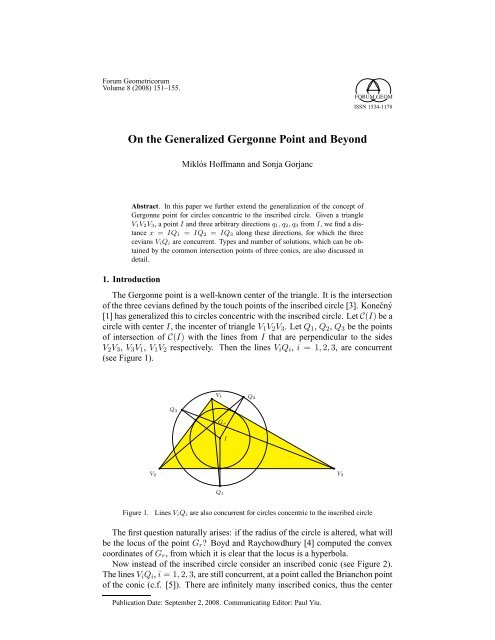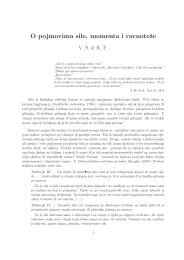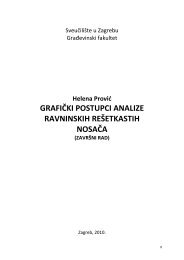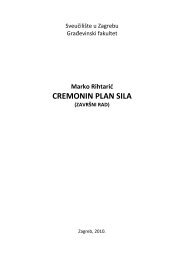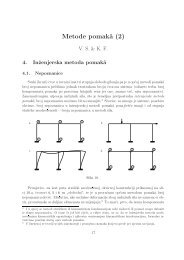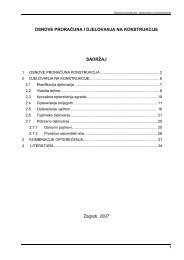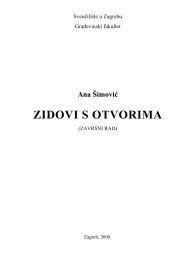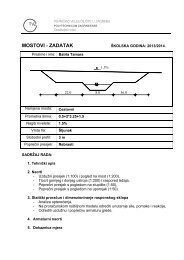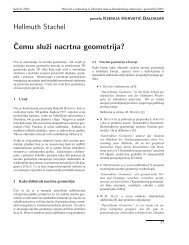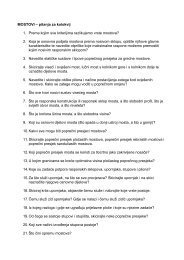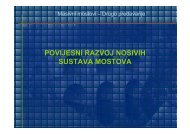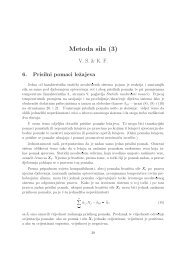On the Generalized Gergonne Point and Beyond - Forum ...
On the Generalized Gergonne Point and Beyond - Forum ...
On the Generalized Gergonne Point and Beyond - Forum ...
You also want an ePaper? Increase the reach of your titles
YUMPU automatically turns print PDFs into web optimized ePapers that Google loves.
•<br />
•<br />
<strong>Forum</strong> Geometricorum<br />
Volume 8 (2008) 151–155. • •<br />
FORUM GEOM<br />
ISSN 1534-1178<br />
<strong>On</strong> <strong>the</strong> <strong>Generalized</strong> <strong>Gergonne</strong> <strong>Point</strong> <strong>and</strong> <strong>Beyond</strong><br />
Miklós Hoffmann <strong>and</strong> Sonja Gorjanc<br />
Abstract. In this paper we fur<strong>the</strong>r extend <strong>the</strong> generalization of <strong>the</strong> concept of<br />
<strong>Gergonne</strong> point for circles concentric to <strong>the</strong> inscribed circle. Given a triangle<br />
V 1V 2V 3, a point I <strong>and</strong> three arbitrary directions q 1, q 2, q 3 from I, we find a distance<br />
x = IQ 1 = IQ 2 = IQ 3 along <strong>the</strong>se directions, for which <strong>the</strong> three<br />
cevians V iQ i are concurrent. Types <strong>and</strong> number of solutions, which can be obtained<br />
by <strong>the</strong> common intersection points of three conics, are also discussed in<br />
detail.<br />
1. Introduction<br />
The <strong>Gergonne</strong> point is a well-known center of <strong>the</strong> triangle. It is <strong>the</strong> intersection<br />
of <strong>the</strong> three cevians defined by <strong>the</strong> touch points of <strong>the</strong> inscribed circle [3]. Konečný<br />
[1] has generalized this to circles concentric with <strong>the</strong> inscribed circle. Let C(I) be a<br />
circle with center I, <strong>the</strong> incenter of triangle V 1 V 2 V 3 . Let Q 1 , Q 2 , Q 3 be <strong>the</strong> points<br />
of intersection of C(I) with <strong>the</strong> lines from I that are perpendicular to <strong>the</strong> sides<br />
V 2 V 3 , V 3 V 1 , V 1 V 2 respectively. Then <strong>the</strong> lines V i Q i , i = 1,2,3, are concurrent<br />
(see Figure 1).<br />
V 1 Q 2<br />
Q 3<br />
G r<br />
I<br />
V 2 V 3<br />
Q 1<br />
Figure 1.<br />
Lines V iQ i are also concurrent for circles concentric to <strong>the</strong> inscribed circle<br />
The first question naturally arises: if <strong>the</strong> radius of <strong>the</strong> circle is altered, what will<br />
be <strong>the</strong> locus of <strong>the</strong> point G r Boyd <strong>and</strong> Raychowdhury [4] computed <strong>the</strong> convex<br />
coordinates of G r , from which it is clear that <strong>the</strong> locus is a hyperbola.<br />
Now instead of <strong>the</strong> inscribed circle consider an inscribed conic (see Figure 2).<br />
The lines V i Q i , i = 1,2,3, are still concurrent, at a point called <strong>the</strong> Brianchon point<br />
of <strong>the</strong> conic (c.f. [5]). There are infinitely many inscribed conics, thus <strong>the</strong> center<br />
Publication Date: September 2, 2008. Communicating Editor: Paul Yiu.
152 M. Hoffmann <strong>and</strong> S. Gorjanc<br />
V 1<br />
V 1<br />
Q 2<br />
Q 2<br />
I<br />
Q 3 I<br />
Q 3<br />
V 3<br />
Q 1<br />
Q 1<br />
V 2<br />
V 2<br />
V 3<br />
Figure 2. Inscribed ellipse <strong>and</strong> its directions IQ i<br />
I <strong>and</strong> directions q i (corresponding to <strong>the</strong> line connecting I <strong>and</strong> Q i ) can be chosen<br />
in many ways, but not arbitrarily. Note that <strong>the</strong> center completely determines <strong>the</strong><br />
inscribed conic <strong>and</strong> <strong>the</strong> points of tangency Q 1 , Q 2 , Q 3 .<br />
Using <strong>the</strong>se directions we generalize <strong>the</strong> concept of concentric circles: given a<br />
triangle V 1 V 2 V 3 <strong>and</strong> an inscribed conic with center I <strong>and</strong> touch points Q 1 , Q 2 , Q 3 ,<br />
consider <strong>the</strong> three lines q i connecting I <strong>and</strong> Q i respectively. A circle with center I<br />
has to be found which meets <strong>the</strong> lines q i at ¯Q i such that <strong>the</strong> lines V i ¯Qi , i = 1,2,3,<br />
are concurrent. In fact, as we will see in <strong>the</strong> next section, we do not have to restrict<br />
ourselves in terms of <strong>the</strong> position of <strong>the</strong> center <strong>and</strong> <strong>the</strong> given directions.<br />
2. The general problem <strong>and</strong> its solution<br />
The general problem can be formulated as follows: given a triangle V 1 V 2 V 3 , a<br />
point I <strong>and</strong> three arbitrary directions q i , find a distance x = IQ 1 = IQ 2 = IQ 3<br />
along <strong>the</strong>se directions, for which <strong>the</strong> three cevians V i Q i are concurrent. In general<br />
<strong>the</strong>se lines will not meet in one point (see Figure 3): instead of one single center G<br />
we have three different intersection points G 12 , G 13 <strong>and</strong> G 23 .<br />
In <strong>the</strong> following <strong>the</strong>orem we will prove that altering <strong>the</strong> value x, <strong>the</strong> points<br />
G 12 ,G 13 <strong>and</strong> G 23 will separately move on three conics. If <strong>the</strong>re is a solution to our<br />
generalized problem, it would mean that <strong>the</strong>se conics have to meet in one common<br />
point. It is easy to observe that each pair of conics have two common points at I<br />
<strong>and</strong> a vertex of <strong>the</strong> triangle. Here we prove that <strong>the</strong> o<strong>the</strong>r two intersection points<br />
can be common for all <strong>the</strong> three conics. Previously mentioned special cases are<br />
excluded from this point.<br />
Theorem 1. Let V 1 ,V 2 ,V 3 <strong>and</strong> I be four points in <strong>the</strong> plane in general positions.<br />
Let q 1 ,q 2 ,q 3 be three different oriented lines through I (V i ∉ q i ). There exist
<strong>On</strong> <strong>the</strong> generalized <strong>Gergonne</strong> point <strong>and</strong> beyond 153<br />
V 1<br />
Q 3<br />
G 13<br />
I<br />
G 12<br />
G 23<br />
V 2 V 3<br />
Q 1<br />
Q 2<br />
Figure 3. For arbitrary directions <strong>and</strong> distance, cevians V iQ i are generally not<br />
concurrent, but meet at three different points<br />
at most two values x ∈ R\{0} such that for points Q i along <strong>the</strong> lines q i with<br />
IQ 1 = IQ 2 = IQ 3 = x, <strong>the</strong> lines V i Q i are concurrent.<br />
Proof. For a real number x <strong>and</strong> i = 1,2,3, let Q i (x) be a point on q i for which<br />
IQ i (x) = x. The correspondences Q i (x) ↔ Q j (x) define perspectivities (q i ) <br />
(q j ), (i ≠ j).<br />
Now let l i (x) be <strong>the</strong> line connecting V i <strong>and</strong> Q i (x). The correspondences l i (x) ↔<br />
l j (x) define projectivities (V i ) ⊼ (V j ), (i ≠ j). The intersection points of corresponding<br />
lines of <strong>the</strong>se projectivities lie on three conics:<br />
(V 1 ) ⊼ (V 2 ) ⇒ c 3<br />
(V 1 ) ⊼ (V 3 ) ⇒ c 2<br />
(V 2 ) ⊼ (V 3 ) ⇒ c 1 .<br />
We find <strong>the</strong> intersection points of <strong>the</strong>se conics. Since Q i (0) = I, <strong>the</strong>n I ∈<br />
c i ,(i = 1,2,3). V 3 ∈ c 1 ∩ c 2 , V 2 ∈ c 1 ∩ c 3 <strong>and</strong> V 1 ∈ c 2 ∩ c 3 also hold. Denote <strong>the</strong><br />
o<strong>the</strong>r two intersection points of c 1 <strong>and</strong> c 2 by S 1 <strong>and</strong> S 2 , i.e.,<br />
c 2 ∩ c 3 = {I,V 1 ,S 1 ,S 2 }.<br />
The points S 1 <strong>and</strong> S 2 can be real <strong>and</strong> distinct, real <strong>and</strong> identical, or imaginary in<br />
pair.<br />
(i) If <strong>the</strong>y are real <strong>and</strong> distinct, <strong>the</strong>n for some x 1 <strong>and</strong> x 2 ,<br />
S 1 = l 1 (x 1 ) ∩ l 2 (x 1 ) = l 1 (x 1 ) ∩ l 3 (x 1 ) ⇒ S 1 = l 2 (x 1 ) ∩ l 3 (x 1 )<br />
S 2 = l 1 (x 2 ) ∩ l 2 (x 2 ) = l 1 (x 2 ) ∩ l 3 (x 2 ) ⇒ S 2 = l 2 (x 2 ) ∩ l 3 (x 2 )<br />
which immediately yields S 1 ,S 2 ∈ c 1 as well.<br />
(ii) If <strong>the</strong>y are identical, <strong>the</strong>n for <strong>the</strong> unique x,<br />
S = l 1 (x) ∩ l 2 (x) = l 1 (x) ∩ l 3 (x) ⇒ S = l 2 (x) ∩ l 3 (x)<br />
which yields S ∈ c 1 .
154 M. Hoffmann <strong>and</strong> S. Gorjanc<br />
Figure 4. Given a triangle V 1V 2V 2 <strong>and</strong> directions q i(i = 1,2, 3) <strong>the</strong>re can<br />
be two different real solutions (upper figure), two coinciding solutions (bottom<br />
right) <strong>and</strong> two imaginary solutions (bottom left). Cevians are plotted by dashed<br />
lines. The type of solutions depends on <strong>the</strong> relative position of I to <strong>the</strong> shaded<br />
conic. The three conic paths of G 12 (green), G 13 (red) <strong>and</strong> G 23 (blue) are also<br />
shown. (This figure is computed <strong>and</strong> plotted by <strong>the</strong> software Ma<strong>the</strong>matica)<br />
(iii) If <strong>the</strong> points S 1 <strong>and</strong> S 2 are <strong>the</strong> pair of imaginary points <strong>the</strong>re are no real<br />
number x for which <strong>the</strong> lines V i Q i are concurrent.<br />
□<br />
Figure 4 shows <strong>the</strong> three different possibilities mentioned in <strong>the</strong> proof. If <strong>the</strong><br />
triangle <strong>and</strong> <strong>the</strong> directions q i , i = 1,2,3, are fixed, <strong>the</strong>n <strong>the</strong> radius of <strong>the</strong> circle can<br />
be obtained by <strong>the</strong> solutions of a quadratic equation in which <strong>the</strong> only unknown<br />
is <strong>the</strong> point I. The type of <strong>the</strong> solutions depends on <strong>the</strong> discriminant, which is a<br />
quadratic function of I. This means that for every triangle <strong>and</strong> triple of directions<br />
<strong>the</strong>re exists a conic which separates <strong>the</strong> possible positions of I in <strong>the</strong> following<br />
way: if I is outside <strong>the</strong> conic (discriminant > 0) <strong>the</strong>n <strong>the</strong>re are two different real<br />
solutions, if I is on <strong>the</strong> conic (discriminant = 0) <strong>the</strong>n <strong>the</strong>re are two coinciding
<strong>On</strong> <strong>the</strong> generalized <strong>Gergonne</strong> point <strong>and</strong> beyond 155<br />
real solutions, while if I is inside <strong>the</strong> conic (discriminant < 0) <strong>the</strong>n <strong>the</strong>re are two<br />
imaginary solutions. This conic is also shown in Figure 4.<br />
Remarks. (1) Note that <strong>the</strong>re are no fur<strong>the</strong>r restrictions for <strong>the</strong> positions of <strong>the</strong><br />
center <strong>and</strong> <strong>the</strong> directed lines. The center can even be outside <strong>the</strong> reference triangle.<br />
(2) According to <strong>the</strong> projective principles in <strong>the</strong> proof, <strong>the</strong> statement remains<br />
valid if we replace <strong>the</strong> condition IQ 1 = IQ 2 = IQ 3 = x with <strong>the</strong> more condition<br />
that <strong>the</strong> ratios of <strong>the</strong>se lengths be fixed.<br />
3. Fur<strong>the</strong>r research<br />
The conics c i , i = 1,2,3, play a central role in <strong>the</strong> proof. The affine types of<br />
<strong>the</strong>se conics however, can only be determined by analytical approach or by closer<br />
study <strong>the</strong> type of involutive pencils determined by cevians. It is also a topic of fur<strong>the</strong>r<br />
research how <strong>the</strong> types of solutions depend on <strong>the</strong> ratios mentioned in Remark<br />
2. The exact representation of <strong>the</strong> length of <strong>the</strong> radius by <strong>the</strong> given data can also be<br />
discussed analytically in a fur<strong>the</strong>r study.<br />
References<br />
[1] V. Konečný, J. Heuver, <strong>and</strong> R. E. Pfiefer, Problem 1320 <strong>and</strong> solutions, Math. Mag., 62 (1989)<br />
137; 63 (1990) 130–131.<br />
[2] B. Wojtowicz, Desargues’ Configuration in a Special Layout, Journal for Geometry <strong>and</strong> Graphics,<br />
7 (2003) 191–199.<br />
[3] W. Gallatly, The modern geometry of <strong>the</strong> triangle, Hodgson Publisher, London, 1910.<br />
[4] J. N. Boyd <strong>and</strong> P. N. Raychowdhury, P.N.: The <strong>Gergonne</strong> point generalized through convex<br />
coordinates, Int. J. Math. Math. Sci., 22 (1999), 423–430.<br />
[5] O. Veblen <strong>and</strong> J. W. Young, Projective Geometry, Boston, MA, Ginn, 1938.<br />
Miklós Hoffmann: Institute of Ma<strong>the</strong>matics <strong>and</strong> Computer Science, Károly Eszterházy College,<br />
Eger, Hungary<br />
E-mail address: hofi@ektf.hu<br />
Sonja Gorjanc: Department of Ma<strong>the</strong>matics, Faculty of Civil Engineering, University of Zagreb,<br />
Zagreb, Croatia


